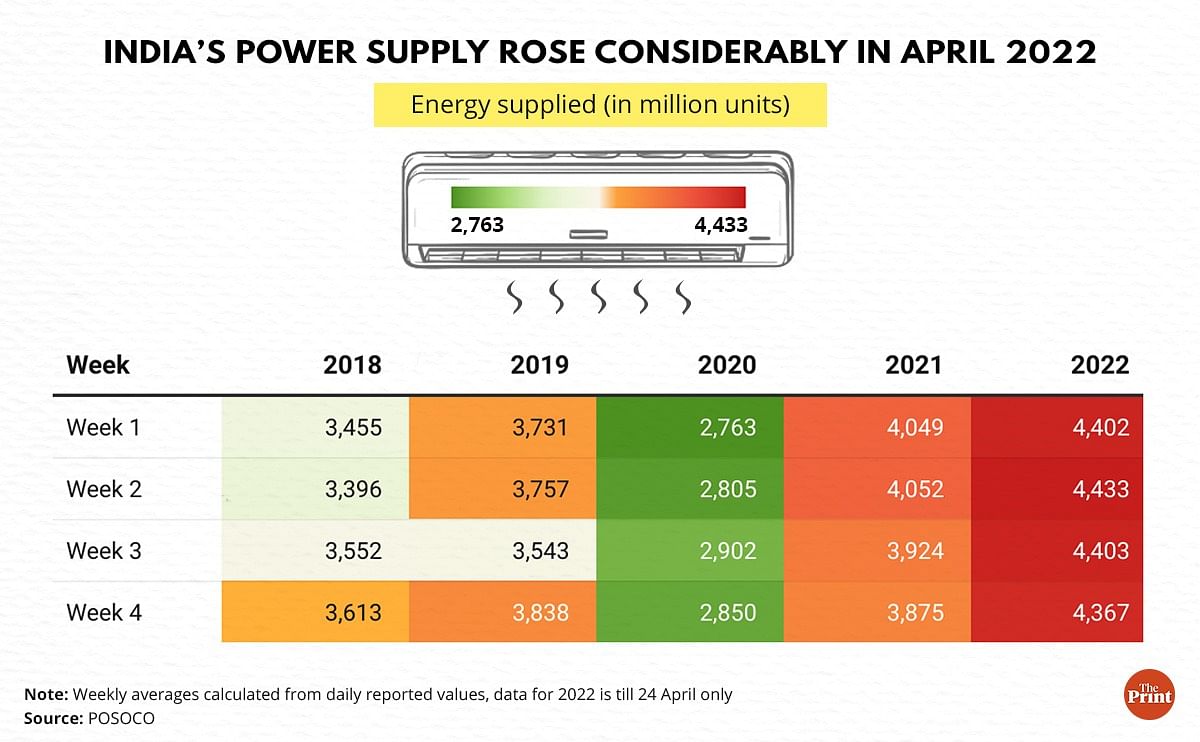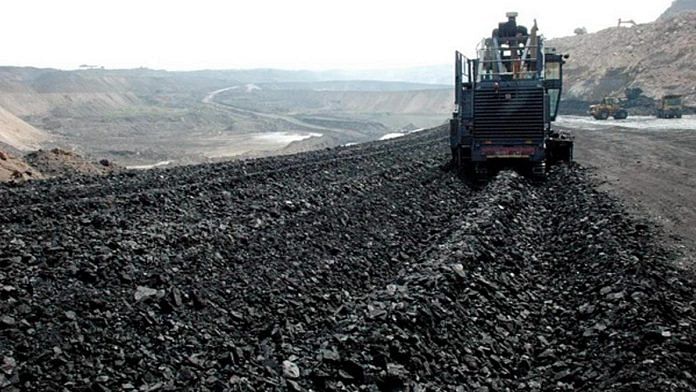New Delhi: As the heatwave intensifies in the country, so has the squabbling between the Centre and the states over power outages, with the latter claiming they have inadequate coal supply for electricity generation.
Uttar Pradesh, Punjab, Maharashtra, Haryana, Tamil Nadu, and Andhra Pradesh are facing some of the longest power cuts in the country.
States claim that the Centre did not anticipate a sudden surge in power demand, which generally peaks towards the end of April but came earlier this year because of the heatwave sweeping the country.
Another factor that has contributed to long power cuts is that several states are shying away from buying expensive power, owing to demand-supply mismatch.
The global coal prices, as monitored by Markets Insider, were hovering around $326 per tonne on 22 April against $120 per tonne in January.
For comparison, coal cost $50 a tonne in 2020, meaning that its price has gone up over six times in just over two years.
Last week, several states urged the Centre to increase the coal supplied to them.
Maharashtra Deputy Chief Minister Ajit Pawar claimed inadequate coal supply forced him to consider alternatives to bridge the supply shortfall of around 3,500-4,000 MW. Tamil Nadu Chief Minister M.K. Stalin asked Prime Minister Narendra Modi to honour their Fuel Supply Agreement (FSA) and supply the promised 72,000 metric tonnes of coal a day to the Paradip and Visakhapatnam ports.
A third important reason why power outages have become a burning issue is the inadequate supply to industries. For context, Tamil Nadu and Maharashtra are among the most industralised states in the country.
ThePrint looks at all these reasons sequentially.
Also Read: Power crisis looms in Punjab as coal shortage hits plants amid summer demand surge
The problem
One of the main reasons for the coal shortage in April has been the pace at which the demand for power has risen this year in comparison to the last few years.
In 2021, the demand increased to 124.2 billion units (BU) a month from 106.6 BU a month in 2019. In 2022, the demand has further increased to 132 BU per month.
This increase in power consumption corresponds with the heatwave sweeping the country. The India Meteorological Department (IMD) has announced a heatwave in the north and northwestern parts of the country, where the temperature is already soaring above 40 degrees Celsius.
Power consumption data provided by Power System Operation Corporation Limited (POSOCO) — the agency that monitors electricity supply in the country — shows that India’s power consumption in the month of April this year is considerably higher than in the last four years.
According to POSOCO’s daily reports, India supplied about 4,400 million units (MU) of energy on a daily basis from 1 to 25 April this year. For comparison, India supplied about 3,500 MUs of energy on a daily basis in April on average from 2018 till 2021 (except for 2020), implying a more than 25 per cent increase in power consumption in the month this year.
(We exclude 2020 data since it was impacted by complete lockdowns everywhere)

The Centre formed a Core Management Team (CMT) in August 2021 to monitor the coal supply to power plants in India. The CMT comprised representatives from the power ministry, Central Electricity Authority and Coal India Limited (CIL), the government said in a press release.
Despite this, however, India was left with only four days of stock last October because of a delay in the shipping of coal stocks.
The CMT said that another reason for limited coal stock has been the heavy rains in coal mining areas like Gujarat, Punjab, Rajasthan, Delhi and Tamil Nadu, which adversely impacted coal production. The Centre said there was a 43.6 per cent reduction in power generation from imported coal, which led to extra demand of 17.4 million tonnes of domestic coal.
As of 24 April, coal stocks at 173 plants across the country stood at 21.77 million tonnes against a requirement of 66.33 million tonnes of coal, according to data from the CEA. Out of the 173, 108 power plants have critically low stocks — below 25 per cent of the required level, the CEA data shows. This level, called the normative level, depends on the demand and varies from plant to plant.
In more than 50 thermal plants, the stock has fallen below the 10 per cent mark, leading to states seeking additional coal supplies from Coal India Ltd (CIL), CEA’s data shows.
Seventy-six per cent of the country’s overall power generation is met through coal-fired plants, while hydro, lignite, solar, wind and biomass, among others, account for the rest. Of this, over 12 per cent is import-based coal.
Additionally, the Russia-Ukraine war led to a disruption in international coal supply, making the imports much more expensive.

Centre refutes allegations
The central government has denied any coal shortage. Union Coal Minister Pralhad Joshi told ThePrint that 72.5 million tonnes of coal is currently available at different sources — such as Coal India Ltd, Singareni Colleries Co Ltd, coal washeries (facilities that wash, separate and grade coal) — and 22.01 million tonnes of coal is available at thermal power plants.
The ministry also dismissed coal shortage allegations in a tweet 24 April.
Ample coal is available in the nation which is being refilled regularly with record production and will serve us for another month. Currently, 72.5 MT of coal is present at different sources like stock with @CoalIndiaHQ, SCCL, washeries, etc., and 22.01 MT with TPPs. pic.twitter.com/RMh7bbmbCi
— Coal Ministry (@CoalMinistry) April 24, 2022
“Coal companies are dispatching almost 2 million tonnes of coal every day to power sector through various modes, such as railways, roadways and RCR (road-cum-rail) mode,” Joshi said in the tweet, adding that the power-generating companies have also been offered an additional 16.7 million tonnes of coal with an option to lift this quantity through road-cum-rail mode.
Coal Secretary Anil Kumar Jain said the current power crisis is not due to the unavailability of domestic coal but due to a decline in electricity generation from different fuel sources, news agency PTI reported Sunday.
According to the coal ministry, the total coal production in the financial year 2021-22 rose 8.5 per cent to 777.23 million tonnes from 716 million tonnes during 2020-21. For state-owned Coal India, the production rose 4.4 per cent to 622.6 million tonnes in 2021-22.
The total coal dispatched during the financial year ended March increased 18.4 per cent to 818.04 million tonnes from 690.7 million tonnes in 2020-21.
Also Read: India has a new energy headache — coal studded with rocks and mud
How coal shortage affects power costs
Fitch Ratings said in a report dated 7 April that India is likely to face high short-term electricity rates due to challenges in increasing power generation.
The report said there was an increase in the daily electricity deficit to 1 per cent from an average of 0.3 per cent in March due to demand-supply mismatch. The rating agency said it expects this deficit to rise in the coming days even as the government is looking to increase coal imports for blending with domestic coal to ease supply issues.
Coal blending is a technique where domestic coal is blended with coal imports to help meet quality specifications for different purposes.
Last week, Power Minister R.K. Singh held a meeting with representatives from 11 states.
As a policy of the Narendra Modi government since 2016, it was promised that India would reduce its dependence on coal imports. However, at the meeting with states last week, the Centre agreed to allow them to import up to 10 per cent of coal for blending to reduce the pressure on domestic supplies.
“The plan is to allow states to import coal, even at higher costs, which will be passed on to the end-consumer till December 2022. Most of the quantity is expected to be delivered between May and July this year. A review of the situation will be conducted in the last week of April,” The Hindu Business Line reported on 23 April.
However, this may not be easy: The Fitch report said that exorbitantly high international coal prices would limit any significant increase in coal imports. “Domestic coal supplies could also be affected at the peak of the monsoon in July-September quarter, which may hurt coal mining and transportation,” the report said.
(Edited by Uttara Ramaswamy)
Also Read: Anatomy of Gujarat’s ‘Rs 6,000-cr coal scam’: UPA-era MSME subsidy that beneficiaries ‘never got’



